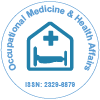Biohazards: Understanding Risks and Prevention
Received: 01-May-2025 / Manuscript No. omha-25-171458 / Editor assigned: 03-May-2025 / PreQC No. omha-25-171458 / Reviewed: 17-May-2025 / QC No. omha-25-171458 / Revised: 22-May-2025 / Manuscript No. omha-25-171458 / Published Date: 29-May-2025 DOI: 10.4172/2329-6879.1000578
Introduction
Biohazards, short for biological hazards, refer to harmful biological substances that pose a risk to human health, animals, or the environment. These hazards include microorganisms such as bacteria, viruses, fungi, parasites, and biological toxins that can lead to infection, disease, or even death. Biohazards are encountered in various settings, including hospitals, laboratories, agriculture, and everyday life. With the growing interconnectedness of societies and the rise of emerging infectious diseases, understanding biohazards and implementing preventive measures is vital for safeguarding public health and the ecosystem [1],[2].
Discussion
Biohazards are typically categorized into four biosafety levels, ranging from low to high risk. Biosafety Level 1 (BSL-1) covers organisms that pose minimal threat, such as non-pathogenic strains of E. coli. BSL-2 includes agents that can cause moderate diseases, such as hepatitis B virus or Salmonella. BSL-3 involves dangerous pathogens like Mycobacterium tuberculosis, which require stricter safety measures. BSL-4 includes the most lethal organisms, such as the Ebola and Marburg viruses, requiring maximum containment facilities [3-6].
Exposure to biohazards can occur through direct contact, inhalation, ingestion, or accidental injection. For example, healthcare workers are often at risk of contracting bloodborne pathogens like HIV and hepatitis from contaminated needles. Similarly, farmers and veterinarians may be exposed to zoonotic diseases, which spread from animals to humans, such as avian influenza. Improper disposal of biomedical waste is another major source of hazard, as contaminated sharps, blood, and tissue can spread infectious agents to communities and the environment [,].
The consequences of biohazard exposure extend beyond individual health, impacting entire populations and ecosystems. Epidemics and pandemics, such as COVID-19, highlight how quickly pathogens can spread globally and overwhelm healthcare systems. Beyond human health, biohazards can disrupt agriculture by affecting livestock and crops, leading to economic losses and food insecurity. Environmental contamination caused by improper handling of waste or laboratory leaks further amplifies these risks [,].
Preventing and managing biohazards requires a multifaceted approach. Strict adherence to biosafety protocols in laboratories, proper use of personal protective equipment (PPE), and safe waste disposal are crucial. Vaccination programs and surveillance systems help reduce the spread of infectious diseases. Training healthcare workers, laboratory staff, and the general public is equally important for raising awareness and ensuring preparedness. International cooperation also plays a critical role, as pathogens do not respect borders; sharing research, resources, and best practices enhances collective security.
Conclusion
Biohazards represent one of the most significant challenges to human health, agriculture, and the environment. Their potential to cause widespread harm underscores the importance of awareness, prevention, and global cooperation. By investing in biosafety measures, education, and international collaboration, societies can mitigate the risks posed by biohazards while continuing to benefit from scientific and medical advancements. Ultimately, safeguarding against biohazards is not only a matter of protecting individuals but also of preserving the well-being of entire communities and ecosystems.
References
- Von-Seidlein L, Kim DR, Ali M, Lee HH, Wang X, Thiem VD, et al. (2006) A multicentre study of Shigella diarrhoea in six Asian countries: Disease burden, clinical manifestations, and microbiology. PLoS Med 3: e353.
- Germani Y, Sansonetti PJ (2006) The genus Shigella. The prokaryotes In: Proteobacteria: Gamma Subclass Berlin: Springer 6: 99-122.
- Aggarwal P, Uppal B, Ghosh R, Krishna Prakash S, Chakravarti A, et al. (2016) Multi drug resistance and extended spectrum beta lactamases in clinical isolates of Shigella: a study from New Delhi, India. Travel Med Infect Dis 14: 407–413.
- Taneja N, Mewara A (2016) Shigellosis: epidemiology in India. Indian J Med Res 143: 565-576.
- Farshad S, Sheikhi R, Japoni A, Basiri E, Alborzi A (2006) Characterizationof Shigella strains in Iran by plasmid profile analysis and PCR amplification of ipa genes. J Clin Microbiol 44: 2879–2883.
- Jomezadeh N, Babamoradi S, Kalantar E, Javaherizadeh H (2014) Isolation and antibiotic susceptibility of Shigella species from stool samplesamong hospitalized children in Abadan, Iran. Gastroenterol Hepatol Bed Bench 7: 218.
- Sangeetha A, Parija SC, Mandal J, Krishnamurthy S (2014) Clinical and microbiological profiles of shigellosis in children. J Health Popul Nutr 32: 580.
- Ranjbar R, Dallal MMS, Talebi M, Pourshafie MR (2008) Increased isolation and characterization of Shigella sonnei obtained from hospitalized children in Tehran, Iran. J Health Popul Nutr 26: 426.
- Zhang J, Jin H, Hu J, Yuan Z, Shi W, Yang X, et al. (2014) Antimicrobial resistance of Shigella spp. from humans in Shanghai, China, 2004–2011. Diagn Microbiol Infect Dis 78: 282–286.
- Pourakbari B, Mamishi S, Mashoori N, Mahboobi N, Ashtiani MH, Afsharpaiman S, et al. (2010) Frequency and antimicrobial susceptibility of Shigella species isolated in children medical center hospital, Tehran, Iran, 2001–2006. Braz J Infect Dis 14: 153–157.
Citation: Mateus O (2025) Biohazards: Understanding Risks and Prevention. Occup Med Health 13: 578. DOI: 10.4172/2329-6879.1000578
Copyright: © 2025 Mateus O. This is an open-access article distributed under the terms of the Creative Commons Attribution License, which permits unrestricted use, distribution, and reproduction in any medium, provided the original author and source are credited.
Select your language of interest to view the total content in your interested language
Share This Article
Recommended Journals
Open Access Journals
Article Tools
Article Usage
- Total views: 42
- [From(publication date): 0-0 - Nov 06, 2025]
- Breakdown by view type
- HTML page views: 26
- PDF downloads: 16
